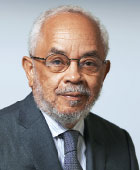Talking About Freedom With Louis Menand

It is not a habit of mine to listen to podcasts. Purely by accident in June, I came across The New York Times’ “Book Review Podcast” and “The Ezra Klein Show.” The hosts conducted separate interviews of Louis Menand, the popular Harvard professor, critic, and staff writer for The New Yorker. On each occasion, he discussed his new book, The Free World: Art and Thought in the Cold War. The research for the text and its preparation apparently took him about 10 years. I also reviewed the written transcript of the discussion from “The Ezra Klein Show,” titled “The Freeing of the American Mind.”
Menand’s book focused on the first 20 years of the Cold War between 1945 and 1965. Ezra Klein noted that in those two postwar decades between the end of World War II and the emergence of the Vietnam conflict, “ideas were born out of interactions between individuals and larger historical forces.” Menand was interested in two types of transformation: those coming from ideas of freedom that powered the arts in new directions and the sociocultural and political changes wrought by major historical forces such as civil rights, the women’s movement, and decolonization.
Menand noted his special interest in biography and social history. These disciplines led him to consider how the major movements affected the artistic creativity of several important figures, among them James Baldwin, Jackson Pollack, Jean-Paul Sartre, and Susan Sontag. Pollack’s experimentation with the “drip paintings” did not evoke pleasant reactions everywhere. Neither did John Cage convince everyone that the “4 minutes and 33 seconds” of purposeful silence in one of his compositions was a new and worthwhile form of music. Evidently, these fresh expressions of artistic freedom were not comprehensively welcomed by consumers. Nevertheless, change was in the air, and some forms had staying power. Baldwin and Sontag were good examples, even though they also had their detractors.
It was understandable that the happenings wrought by Nazi Germany throughout Europe and elsewhere had affected almost everyone’s defining search for liberty. In the sociocultural and political spheres, this was evident in the demands of the Black American soldiers returning from Europe and in Sontag’s contributions to the women’s movement. These developments in the social, cultural, and political spheres have left their mark on us today, as many witnesses have stated in the last months. Nevertheless, Menand and his interviewers articulated differences between the “freedom” of the 1950s and the present. For example, Menand noted that Martin Luther King Jr. used “freedom” frequently without adding “equality,” although he is confident that King did believe in equality. In contrast, George Wallace used “freedom” to justify resistance to enforced segregation. Menand clarified that the foundation of the current civil rights movement is equality. This differentiated discourse, as Menand talked about freedom, highlights the complexity of such conversations. Even I never imagined in the decade of the 1960s that conceptualizing freedom would become so complicated in the coming century.
I found it fascinating to contemplate, in personal terms, the reactive quest for freedom in response to historic movements across wide swaths of geography. This was both on the platforms of culture and of politics. Concerning culture, I have already mentioned the rise of the steel pan in Caribbean countries (Psychiatric News) as a visibly powerful and indigenous musical instrument. I have also described its use in European classical music as well as its application to the compositions authored by local artists. I have marveled, too, at the insightful commentary proposed by Caribbean theorists like Professors Frederick Hickling and Richard Drayton. I have loved their work concerning sovereign independence and its implications for freedom in many spheres of mundane living.
There is also the matter of how Menand’s theorizing applies to my experience in the academic context, to “elite universities,” as he refers to them. Menand seems enamored of the improved access of different social classes to our universities. The class of cultural consumers has widened. That is a good thing. It has also led to greater awareness of social injustice and racial inequity. Menand pointed also to universities’ drive to be inclusive now, going “to enormous lengths to make students feel welcome and comfortable, regardless of their backgrounds.”
I agree that some universities are pursuing this change vigorously. However, not all have jumped on the bandwagon. I still also find myself uncomfortable with some university leaders’ notions of leadership. They make little effort to imbue their management style with empathy and recognition of the other’s dignity. Menand sees this as a “tension” and thinks the university is a wonderful place to work out these tensions. We shall see. ■



